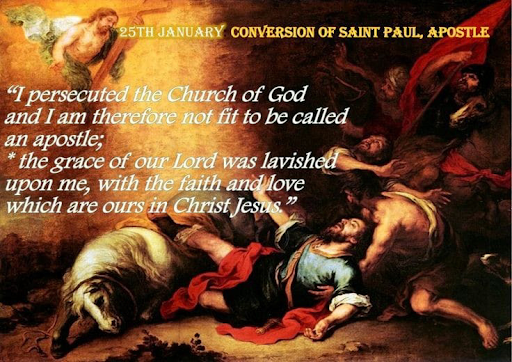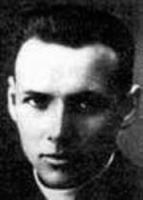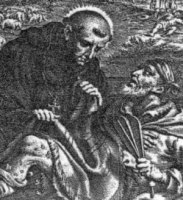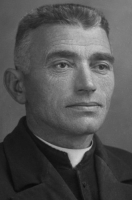Conversion of Saint Paul
பவுலின் மனமாற்ற விழா
அக்காலத்தில் சவுல் சீறியெழுந்து எழுந்து ஆண்டவருடைய சீடர்களை கொன்றுவிடுவதாக அச்சுறுத்தி வந்தார். ஆண் பெண்களை கொன்றுவிட அனுமதிபெற்று தமஸ்கு நோக்கி வரும்வழியில், தீடீரென வானத்தில் ஓர் ஒளி அவரை ஆட்கொண்டது. அவர் தரையில் விழ "சவுலே, சவுலே ஏன் என்னை துன்புறுத்துகின்றாய்?" என்று ஒர் குரல் தொடர்ந்து கேட்டது. அதற்கு அவர் "ஆண்டவரே நீர் யார்?" எனக் கேட்டார். இயேசு மறுமொழியாக "நீ துன்புறுத்தும் இயேசு, நானே!, உடனே நீ நகருக்குள் செல்! நீ என்ன செய்ய வேண்டும் என்று உனக்கு அறிவிக்கப்படும்" என்று கூறினார். அக்குரலை உடனிருந்தவர்களும் கேட்டனர். ஆனால் வியப்பில் ஆழ்ந்தனர். சவுல் எழுந்தபோது கண்கள் திறந்திருந்தும் எதனையும் காணும் திறனை இழந்திருந்தார். உடனிருந்தவர்கள் அவரது கைகளை பிடித்து தமஸ்கு நகருக்கு அழைத்து சென்றார்கள். அங்கே மூன்று நாள் பார்வையற்று இருந்தார். எதுவும் உண்ணவும் குடிக்கவுமில்லை.
அந்நகரில் அனனியா என்ற சீடர் இருந்தார். ஆண்டவர் அவரிடம், “நீ எழுந்து நேர்த்தெரு என்னும் சந்துக்குப் போய் அங்கே தர்சு நகர சவுல் தேடு. அவர் ஒரு காட்சியை கண்டுள்ளார். அக்காட்சியில் அனனியா என்பவர் வந்து சவுல் பார்வையடைய வேண்டுமென்று தமது கைகளை அவர் மீது வைப்பதாக காட்சி கண்டுள்ளார்” என்று கூறினார். அதற்கு அனனியா “அவன் கிறிஸ்துவர்களை அழிக்க கங்கனம் கட்டித்திரிபவன் ஆயிற்றே” என்று கூற, ஆண்டவர் “நீ அங்கு செல், என் மீட்பு பணியை உலகெங்கும் பறைசாற்றிட தேர்ந்து கொண்டவரே அவர்! எனது கருவியாக செயல்படுவார். பிற இனத்தாருக்கும் அரசர்களுக்கும், இஸ்ரயேல் மக்களுக்கும் இயேசுவின் பெயரை எடுத்துரைக்கும் கருவியே! என்றார். என் பொருட்டு அவர் எத்துன்பம் அடைய வேண்டும் என்பதும் அவருக்கு காட்டுவேன்” என்றார்.
உடனே அனனியா நகருக்குச் சென்று தூய ஆவியால் ஆட்கொள்ளப்பட்டு, ஆண்டவர் பெயரால் அவர் மீது கைகளை வைக்க தூய ஆவியின் ஒளி கீற்றுக்கள் அவரது விழிகளை திறக்கச் செய்து அதிலிருந்து செதில்கள் விழுந்தன. மீண்டும் சவுல் பார்வை பெற்றவராய் ஆண்டவரின் ஒளியை பெற்று கிறிஸ்துவின் கருவியாக மாறினார்.
வாழ்க்கை வரலாறு
இன்று நாம் பவுலடியாரின் மனமாற்றப் பெருவிழாவைக் கொண்டாடுகிறோம். அதனால் தூய பவுலைப் பற்றி ஒருசில உண்மைகளை அறிந்துகொள்வோம்.
தூய பவுல் கி.பி. 9 ஆம் ஆண்டளவில் யூதாவின் பன்னிரு குலங்களில் ஒன்றான பெஞ்சமின் குலத்தில் பிறந்தார். இவரது யூதப் பெயர் சவுல். இன்றைய துருக்கி நாட்டின் பகுதியான சிலிசியா மாநிலத்தின் உரோமைக் குடியிருப்பான தர்சு நகரத்தில் இவரது குடும்பம் வாழ்ந்து வந்தது. செல்வமும் செல்வாக்கும் பெற்றிருந்த இவரது குடும்பத்திற்கு உரோமைக் குடியுரிமையும் இருந்தது. இவர் இளமையிலிருந்தே யூதச் சட்டங்களையும் நெறிமுறைகளையும் கற்றறிந்தார். உலகப் பொதுமொழியாயிருந்த கிரேக்கத்தையும் கற்றுத் தெளிந்தார். பின்னர் எருசலேம் சென்று, புகழ்பெற்ற கமாலியேல் என்னும் யூத ரபியிடம் கல்வி பயின்றார். யூதக் கோட்பாடுகளைக் கில்லேல் என்பவரது விளக்கங்களைத் தழுவிக் கடைப்பிடிக்கும் பரிசேயர் சமயப் பிரிவின் ஆர்வமிக்க உறுப்பினராக இருந்தார். இயேசு வாழ்ந்த காலத்தில் இவர் பாலஸ்த்தீனாவில் இருந்திருக்கலாம் எனக் கூற இடம் உண்டு.
இப்படிப்பட்டவர் யூத மதத்தின்மீது இருந்த பற்றினால் கிறிஸ்தவர்களை அதிகமாகத் துன்புறுத்தத் தொடங்கினார். ஸ்தேவானைக் கல்லெறிந்து கொல்வதற்கு இவர் உடன்பட்டிருந்தார் என்று திருத்தூதர் பணிகள் நூலிலே நாம் வாசிக்கின்றோம் (திப8:1). ஒருமுறை கிறிஸ்தவர்களைத் துன்புறுத்துவதற்காகத் தமஸ்கு நகருக்குச் செல்லும் வழியில்தான் ஆண்டவராகிய இயேசு அவரைத் தடுத்து ஆட்கொள்கிறார். அவரை புறவினத்தாருக்கு நற்செய்தி அறிவுக்கும் கருவியாக ஏற்படுத்துகிறார்.
தூய பவுல் ஆண்டவர் இயேசுவின் நற்செய்தியை அறிவிக்க மூன்று திருத்தூதுப் பயணங்களை மேற்கொண்டார் என்று சொல்லப்படுகின்றது. முதல் நற்செய்திப் பயணத்தைக் கி.பி. 46-48 ஆண்டுகளில் மேற்கொண்டு, சைப்பிரசுக்கும் சின்ன ஆசியா நாட்டுப் பகுதிகளுக்கும் சென்று திருச்சபையை நிறுவினார் (திப 13,14; 2 திமொ 3:11). கி.பி. 49 ஆம் ஆண்டில் எருசலேம் பொதுச்சங்கத்தில் கலந்துகொண்டு பிற இனத்தாரிடையே தூய ஆவி செயல்படுதலைப் பற்றி எடுத்துரைத்துத் தமது பணிக்குச் சங்கத்தின் ஒப்புதலைப் பெற்றுக் கொண்டார் (திப15; கலா 2:3-9). கி.பி. 50-52க்கு உட்பட்ட காலத்தில் பவுல் தமது இரண்டாவது நற்செய்திப் பயணத்தை மேற்கொண்டு, தாம் ஏற்கனவே நிறுவிய சபைகளை வலுப்படுத்தினார். பின்னர் மாசிதொனியா, அக்காயா பகுதிகளுக்குச் சென்று நற்செய்தியை அறிவித்து, அங்கும் திருச்சபைகளை நிறுவினார் (திப 15-18). கி.பி. 53-57 வரை மூன்றாம் நற்செய்திப் பயணத்தின்போது கலாத்தியா, பிரிகியா, கொரிந்து, மாசிதோனியா, இல்லிரிக்கம் ஆகிய இடங்களுக்குச் சென்று திருப்பணி ஆற்றினார்.
அதன்பிறகு எபேசு நகரை மையமான பணித்தளமாகக் கொண்டு பவுல் செயல்பட்டார். அங்குச் சிறைப்பட்டார். அக்காலத்தில் அவர் சில சிறைக்கூட மடல்களை எழுதியிருக்கலாம். பின் கி.பி. 58 ஆண்டு எருசலேமில் கைதானார். கி.பி. 60 வரை செசரியாவில் சிறைப்பட்டிருந்தார். உரோமைப் பேரரசர் சீசரே தமக்குத் தீர்ப்பளிக்க வேண்டும் என்று பவுல் கேட்டுக்கொண்டதால் உரோமைக்கு அனுப்பப் பெற்றார். அங்கு போகும் வழியில் கப்பல் அழிவுற நேரிட்டதால் மால்தா தீவினருக்கு நற்செய்தி அறிவிக்கும் வாய்ப்பைப் பெற்றார். பின்பு பவுல் உரோமை வந்தடைந்து இரு ஆண்டுகள் வீட்டுக் கைதியாகவே இருந்துகொண்டு நற்செய்தி அறிவித்து வந்தார். பின்பு பவுல் விடுதலை பெற்று ஸ்பெயின் நாட்டுக்குச் சென்றிருப்பார் என நம்ப இடமிருக்கிறது. மீண்டும் கி.பி. 60 ஆம் ஆண்டு கைதுசெய்யப்பட்டு நீரோ மன்னன் காலத்தில் பவுல் மரண தண்டனை பெற்றார் என மரபு கூறுகிறது.
Article
The great Apostle Paul, named Saul at his circumcision, was born at Tarsus, the capital of Cilicia, and was by privilege a Roman citizen, to which quality a great distinction and several exemptions were granted by the laws of the empire. He was early instructed in the strict observance of the Mosaic law, and lived up to it in the most scrupulous manner. In his zeal for the Jewish law, which he thought the cause of God, he became a violent persecutor of the Christians. He was one of those who combined to murder Saint Stephen, and in the violent persecution of the faithful, which followed the martyrdom of the holy deacon, Saul signalized himself above others. By virtue of the power he had received from the high priest, he dragged the Christians out of their houses, loaded them with chains and thrust them into prison. In the fury of his zeal he applied for a commission to take up all Jews at Damascus who confessed Jesus Christ, and bring them bound to Jerusalem, that they might serve as examples for the others. But God was pleased to show forth in him His patience and mercy. While on his way to Damascus, he and his party were surrounded by a light from heaven, brighter than the sun, and suddenly struck to the ground. And then a voice was heard saying, "Saul, Saul, why dost thou persecute me?" And Saul answered, "Who art thou, Lord?" and the voice replied, "I am Jesus whom thou dost persecute." This mild expostulation of our Redeemer, accompanied with a powerful interior grace, cured Saul's pride, assuaged his rage, and wrought at once a total change in him. Wherefore, trembling and astonished, he cried out, "Lord, what wilt Thou have me to do?" Our Lord ordered him to arise and to proceed on his way to the city, where he should be informed of what was expected from him. Saul, arising from the ground, found that though his eyes were open, he saw nothing. He was led by hand into Damascus, where he was lodged in the house of a Jew named Judas. To this house came by divine appointment a holy man named Ananias, who, laying his hands on Saul, said, "Brother Saul, the Lord Jesus who appeared to thee on thy journey, hath sent me that thou mayest receive thy sight, and be filled with the Holy Ghost." Immediately something like scales fell from Saul's eyes, and he recovered his eyesight. Then he arose, and was baptized; he stayed some few days with the disciples at Damascus, and began immediately to preach in the synagogues that Jesus was the Son of God. Thus a blasphemer and a persecutor was made an apostle, and chosen as one of God's principal instruments in the conversion of the world.
Reflection - Listen to the words of the "Imitation of Christ," and let them sink into your heart: "He who would keep the grace of God, let him be grateful for grace when it is given, and patient when it is taken away. Let him pray that it may be given back to him, and be careful and humble, lest he lose it."
Blessed Henry Suso
Also known as
• Heinrich Seuse
• Heinrich von Berg
• Henrik Seuse
• Amandus
• Servant of the Eternal Wisdom
Additional Memorial
15 February (Dominicans)
Profile
Born to the German nobility. Joined the Dominicans at age 13. Known as a mystic. Served as prior at several houses. Theological student of Meister Eckhart in Cologne, Germany from 1322 to 1325. Taught in Constance, Switzerland. Spent years imprisoned in a dungeon due to slander and his association with Meister Eckhart, a controversial figure in his day. Great spiritual writer, using the pen name Amandus. Noted preacher in Switzerland and the area of the Upper Rhine. Spiritual advisor to Dominicans and the spiritual community called Gottesfreunde
Given to great austeries, Henry owned a half-length, tight-fitting, coarse undergarment equipped with 150 sharp brass nails, the points facing inward; he used it as his night shirt. After 16 years of this, an angel appeared to him on Pentecost Sunday and whispered that God wanted him to discontinue this practice; he threw his shirt into the Rhine.
Born
21 March 1295 at Uberlingen, Germany as Heinrich von Berg
Died
25 January 1366 at Ulm, Germany of natural cause
Beatified
1831 by Pope Gregory XVI
Blessed Antonio Migliorati
Additional Memorial
29 January (Augustinians)
Profile
Son of Simpliciano Migliorati, a farmer whose family had little wealth but great faith. Inspired by the life and work of Saint Nicholas of Tolentino, Antonio joined the Augustinians. Priest. Sacristan of the Augustinian church in Tolentino, Italy, the church that housed the tomb of Saint Nicholas, for twelve years beginning c.1385; he lived in a nearby monastery. Pilgrim to the shrine of Saint Nicholas of Myra. Travelling preacher throughout southern Italy beginning c.1397. Noted for his zeal for the faith, his devotion to the poor, and as a miracle worker. In 1400 he returned to his hometown of Amandola, Ascoli Piceno, Italy where he worked to build an Augustinian monastery and church; originally named for Saint Augustine of Hippo, it was later renamed in honor of Blessed Antonio himself who led it for many of his remaining 50 years there.
Born
17 January 1355 in Amandola, Ascoli Piceno, Italy of natural causes
Died
• 25 January 1450 in the Saint Augustine monastery Amandola, Ascoli Piceno, Italy of natural causes
• buried in the monastery graveyard with his brother Augustinians
• enshrined in a wooden ark in the monastery church in 1453
• re-enshrined in a wooden sarcophagus in 1641
• shrine damaged and body desecrated in 1798 by anti–Christian forces in the French Revolution
• re-enshrined in a marble sacrophagus in 1897
• a gold crown was placed on his head in 1899
• his incorrupt body is still on display in the same church
Beatified
• by 1460, his memorial was a civic holiday in Amandola, Italy
• 11 July 1759 by Pope Clement XIII (cultus confirmation)
• Pope Leo XIII granted a plenary indulgence to visitors to the shrine on 20 April 1890
Saint Dwynwen
Also known as
Dwyn, Donwen, Donwenna, Dunwen
Profile
Beautiful, pious and virtuous daughter of the 5th century Welsh king, Brychan of Brecknock. A certain Maelon fell in love with her, and wished to marry her. Though Dwynwen returned his love, her heart was set on becoming a nun, and she rejected him. She dreamt she was given a sweet drink which saved her from his attentions, but which turned the poor young man to ice. Realising that Maelon couldn't help his love for her, she prayed that he be restored to life, that all lovers should find happiness, and that she never have the desire for marriage. Dwynwen became a nun and lived on Llanddwyn Island on the western coast of Ynys Mon (Anglesey), an area accessible only at low tide.
Her well, a fresh-water spring called Ffynnon Dwynwen, became a wishing well and place of pilgrimage, particularly for lovers because of the story above. The tradition grew that the eel in the well could foretell the future for lovers - ask questions and watch which way they turn. Women would scatter breadcrumbs on the surface, then lay her handkerchief on water's surface; if the eel disturbed it, her lover would be faithful. All this led to her connection with animals, which eventually led to the tradition that her intercession could heal injured animals.
There are churches dedicated to her in Wales and Cornwall. In recent years, her feast day has become increasingly popular among the Welsh with cards being sent just as on Valentine's Day, and her well continues to be a place of pilgrimage; there's a tradition that if the fish in the well are active when a couple visits, it's the sign of a faithful husband.
Died
c.460 of natural causes
Patronage
• lovers (especially Welsh)
• sick animals
Blessed Antoni Swiadek
Also known as
Antoni Witek
Additional Memorial
12 June as one of the 108 Polish Martyrs of World War II
Profile
The son of Wladyslaw and Wladyslawa Swiadek; his father was a wheelwright. After studying at the seminary in Poznan, Poland, he was ordained a priest in the archdiocese of Gniezno, Poland on 10 June 1933. He was noted for his piety, determination and hard work. Pastor, youth minister, military chaplain and Boy Scout leader at the Saint Stanislawa Biskupa i Meczennika parish in Bydgoszcz, Poland.
When the Germans invaded Poland in September 1939, Father Antoni volunteered as military chaplain to the Polish army. When his division was defeated, he served as chaplain to Polish prisoners of war until he was returned to Bydgoszcz. There he concentrated on young people, preparing children for their First Communion, and ignoring Nazi regulations that required all liturgy be celebrated in German. Arrested in July 1942 for his continued loyalty to the Church and his parishioners, he was sentenced to forced labour in the Dachau concentration camp, and worked until he died. Martyr.
Born
27 March 1909 in Pobiedziska, Wielkopolskie, Poland
Died
• 25 January 1945 at the Dachau concentration camp, Oberbayern, Germany of typhus
• he died with a rosary in his hand
• buried in a mass grave near the village of Deutenhofen, Germany
Beatified
13 June 1999 by Pope John Paul II at Warsaw, Poland
Blessed Teresa Grillo Michel
Also known as
• Maddalena Parvopassau
• Maria Antonia
Profile
Youngest of five children born to Giuseppe and Maria Antonietta Parvopassau. Her father was the head physician at the Civil Hospital of Alessandria, Italy, but died when the girl was still very small. Maddalena attended school in Turin, Italy, and then in a boarding school in Lodi, Italy run by the Ladies of Lorreto. At 18 she returned to Alessandria where she married Captain Giovanni Michel on 2 August 1877. In the next few years they lived in the Italian cities of Caserta, Acireale, Catania, Portici and Naples.
Captain Giovanni died of sunstroke during a parade in Naples in 1891, and Teresa sank into a deep depression. However, with the spiritual guidance of her cousin, Monsignor Prelli, she made a recovery and decided to devote herself to helping the poor. She first used her own home to shelter them, but the numbers soon out-stripped the house, and in 1893, with much opposition of her family, she sold it to buy an large old building which she rebult and renamed Little Shelter of Divine Providence. Other local women were attracted to her work, and on 8 January 1899 she and eight of her co-workers officially founded the Congregation of the Little Sisters of Divine Providence. She spent the rest of her life, 45 years, working to spread the Congregation and its mission to the poor. Today they have houses throughout Italy, Brazil and Argentina, running nurseries, orphanages, schools, hospitals, and homes for the elderly.
Born
25 September 1855 in Spinetta Marengo, Alessandria, Italy as Maddalena Parvopassau
Died
25 January 1944 in Alessandria, Italy of natural causes
Beatified
24 May 1998 by Pope John Paul II
Saint Ananias of Damascus
Profile
A Christian in Damascus, Syria, Ananias received a vision of Jesus in which he was ordered to find Saul (aka Paul the Apostle). Ananias found Saul, blind and staggering into the city after his encounter with Christ on the road. He cured Saul of the blindness, baptized him into the faith, supported him while he prepared, and helped him begin his missionary work. Ananias evangelized in Damascus, then went on his own mission to Eleutheropolis. Martyr.
Died
1st century in Eleutheropolis, a now-ruined village in Palestine
Readings
There was a disciple in Damascus named Ananias, and the Lord said to him in a vision, "Ananias."
He answered, "Here I am, Lord."
The Lord said to him, "Get up and go to the street called Straight and ask at the house of Judas for a man from Tarsus named Saul. He is there praying, and (in a vision) he has seen a man named Ananias come in and lay (his) hands on him, that he may regain his sight."
But Ananias replied, "Lord, I have heard from many sources about this man, what evil things he has done to your holy ones in Jerusalem. And here he has authority from the chief priests to imprison all who call upon your name."
But the Lord said to him, "Go, for this man is a chosen instrument of mine to carry my name before Gentiles, kings, and Israelites, and I will show him what he will have to suffer for my name."
So Ananias went and entered the house; laying his hands on him, he said, "Saul, my brother, the Lord has sent me, Jesus who appeared to you on the way by which you came, that you may regain your sight and be filled with the Holy Spirit." Immediately things like scales fell from his eyes and he regained his sight. - Acts 9:10-18a
Saint Poppo
ஸ்டாப்லோ நகர் துறவி போப்போ
பிறப்பு
978,
டெய்ன்சே Deynze, பெல்ஜியம்
இறப்பு
25 ஜனவரி 1048,
மார்கீனெஸ் Marchiennes, பெல்ஜியம்
இவர் நீதிபதிக்கான படிப்பை கற்றார். இவர் 1000 ஆம் ஆண்டு புனித நாட்டிற்கு புனிதப் பயனம் ஒன்றை மேற்கொண்டார். அங்கிருந்து மீண்டும் உரோம் சென்றடைந்தார். அப்போது புனித பேதுரு மற்றும் புனித பவுலின் கல்லறையை சந்தித்தார். அதன்பிறகு அங்கிருந்து ரைம்ஸிற்கு Reims திரும்பி 1005 ஆம் ஆண்டு செயிண்ட் தீயரி St.Thierry என்றழைக்கப்பட்ட துறவற மடத்தில் சேர்ந்தார். அம்மடத்தில் சேர்ந்து 3 ஆண்டுகள் கழித்து அங்கிருந்து செயிண்ட் வான்னே St.Vanne என்ற இடத்திலிருந்த இல்லத்திற்கு மாற்றப்பட்டார். அப்போது புகழ்வாய்ந்த துறவி ரிச்சர்ட் அவர்களிடமிருந்து துறவற வாழ்விற்கு தேவையான சில பயிற்சிகளைப் பெற்றார்.
அச்சமயத்தில் ரிச்சர்ட் ஏறக்குறைய 20 துறவற இல்லங்களை கட்டினார். அவ்வில்லங்கலை கண்காணிக்கும் பொறுப்பை ரிச்சர்ட், போப்போவிற்கு வழங்கினார். போப்போ தன்னிடம் வழங்கிய பணிகளை மிக நேர்மையாக திறம்பட ஆற்றினார். இதன் பயனாக இன்னும் 17 துறவற இல்லங்களை கவனிக்கும் பொறுப்பும் வழங்கப்பட்டது. இவர் தன்னிடம் ஒப்படைக்கப்பட்ட அனைத்துப் பணிக்கும் ஒழுங்குகளை அமைத்து தானும் அதைக்கடைபிடித்து வாழ்ந்தார். உண்மையுள்ள ஊழியனாக எளிமையான வாழ்வை வாழ்ந்தார்.
Also known as
Popon, Poppone
Profile
Born to the Belgian nobility, the son of Tizekinus and Adalwif. His was a pious family; when Poppo was grown, his mother became a nun. Career soldier. Pilgrim to the Holy Lands in 1000, and then to Rome, Italy. While on the road late one night, a flame suddenly lit over his head, and his lance radiated a brilliant light. Poppo took this as a sign of the Holy Spirit, and started considering a religious vocation. Monk at the Saint Theirry monastery at Rheims, France in 1005.
Beginning in 1008 he worked with Abbot Richard of Saint-Vanne to restore order and religious observance to several houses. Prior of the monastery of Saint Vaast in Arras, France in 1013. Prior at Vasloges, France in 1016. Abbot-general for a large group of houses in Lotharingia (in modern France, Germany and Switzerland) in 1020. Abbot of Stavelot-Malmédy in Belgium in 1021.
The monastic revival he led spread to other houses, including Hautmont, Marchiennes, Saint Maximinus of Trier in Germany, and Saint Vaast in Arras in France. He practiced severe personal asceticism, cared nothing for literature, and lacked organization, but managed to bring order and devotion to his houses, earning the love of his brothers and the laity. Unofficial counselor to emperor Saint Henry II on matters of faith, politics, and diplomacy.
Born
978 at Flanders, Belgium
Died
25 January 1048 at Marchiennes, France of natural causes
Blessed Francesco Zirano
Also known as
• Francesco Cirano
• Francesco Cyrano
Profile
Member of the Friars Minor Conventuals, making his profession in 1580. Priest, ordained in 1586. In 1599 he received authorization from Pope Clement VIII to collect funds to ransom Christians who were enslaved and held for ransom by Muslims in North Africa. On 20 August 1602 he arrived in Algiers, Algeria where anti-Christian sentiment was building due to an impending war between Algiers and the kingdom of Cuco; Cuco had the backing of Catholic Spain. On 1 January 1603, following a battle won by the king of Cuco, Father Francesco was dispatched to the Spanish court to take back news; he was betrayed to local Algerian soldiers who captured him and sent him to Algiers in chains. On the morning of 25 January 1603 he received notice that he was condemned to death for being a Christian, but could receive a pardon if he converted to Islam; he declined. Martyr.
Born
c.1564 in Sassari, Italy
Died
flayed alive on 25 January 1603 in Algiers, Algeria
Beatification
• 12 October 2014 by Pope Francis
• beatification recognition celebrated at Sassari, Sardinia, Cardinal Angelo Amato presiding
Blessed Manuel Domingo y Sol
அருளாளர் மேனுவல் டொமிங்கோ
குரு/ நிறுவனர்:
பிறப்பு: ஏப்ரல் 1, 1836
டோர்டோஸா, டர்ரகோனா, ஸ்பெயின் அரசு
இறப்பு: ஜனவரி 25, 1909 (வயது 72)
டோர்டோஸா, டர்ரகோனா, ஸ்பெயின் அரசு
ஏற்கும் சமயம்:
ரோமன் கத்தோலிக்க திருச்சபை
முக்திபேறு பட்டம்: மார்ச் 29, 1987
திருத்தந்தை இரண்டாம் ஜான் பால்
நினைவுத் திருநாள்: ஜனவரி 25
பாதுகாவல்:
திருத்தந்தை ஸ்பேனிஷ் கல்லூரி (Pontifical Spanish College),
இயேசுவின் மாசற்ற இருதயத்தின் மறைமாவட்ட பணியாளர் குருக்கள் (Diocesan Labour Priests of the Sacred Heart of Jesus)
அருளாளர் மேனுவல் டொமிங்கோ, ஒரு ஸ்பேனிஷ் ரோமன் கத்தோலிக்க குரு ஆவார். இவர், ரோம் நகரிலுள்ள “திருத்தந்தையர் ஸ்பேனிஷ் கல்லூரி” (Pontifical Spanish College), மற்றும் “இயேசுவின் மாசற்ற இருதயத்தின் மறைமாவட்ட பணியாளர் குருக்கள்” (Religious Order of the Diocesan Labour Priests of the Sacred Heart of Jesus) சபை ஆகியவற்றின் நிறுவனரும் ஆவார். இவர் ஒரு இளம் குருவாகையால், இளம்பருவத்தினரின் ஈடுபாட்டிற்காக ஒரு விளையாட்டு அரங்கினையும் நாடக அரங்கினையும் கட்டினார்.
வாழ்க்கை:
கி.பி. 1836ம் ஆண்டு, ஏப்ரல் மாதம், முதல் தேதி, ஸ்பெயின் நாட்டின் "டோர்டோஸா" (Tortosa) என்னுமிடத்தில், தமது பெற்றோரின் பன்னிரண்டு குழந்தைகளில் கடைசி குழந்தையாகப் பிறந்த அருளாளர் மேனுவல் டொமிங்கோ, அதே மாதத்திலேயே திருமுழுக்கும் பெற்றார்.
கி.பி. 1851ம் ஆண்டு, தமது ஊரிலேயே குருத்துவ கல்வியை ஆரம்பித்த இவர், கி.பி. 1860ம் ஆண்டு, ஜூன் மாதம், இரண்டாம் தேதி, குருத்துவம் பெற்றார். பின்னர், "வலன்ஸியா கல்லூரிக்கு" (Valencia college) உயர் கல்விக்காக சென்ற இவர், கி.பி. 1865ம் ஆண்டு, "இறையியல் தகுதிச்சான்று" (Licentiate in Theology) பெற்றார். 1865ம் ஆண்டு, தமது பழைய கல்லூரியிலேயே பேராசிரியராக கற்பித்தார்.
கி.பி. 1873ம் ஆண்டு, குளிர்கால ஃபெப்ரவரி மாதத்தின் ஒருநாள் மேனுவல், இறையியல் மாணவரான "ரமோன் வலேரோ" (Ramón Valero) என்பவரைச் சந்தித்தார். " கி.பி. 1868ம் ஆண்டு புரட்சியின்போது" (1868 revolution) அவர் கற்ற "டோர்டோஸா கல்லூரி" (Tortosa seminary) இடிக்கப்பட்டதை அறிந்து வருந்தினார். இச்சம்பவம் இவரது மனதை தொட்டது. இதன்காரணமாக மேனுவல், கி.பி. 1873ம் ஆண்டு, செப்டம்பர் மாதத்தில் இறையியல் மாணவர்களுக்காக "புனித ஜோசப் இல்லம்" ("Saint Joseph's House") தொடங்கி வைத்தார். கி.பி. 1879ம் ஆண்டு, ஏப்ரல் மாதம், 11ம் தேதி, "தேவாலயப் பணிகளுக்கான புனித ஜோசப் கல்லூரி" ("College of Saint Joseph for Ecclesiastical Vocations") என்ற கல்லூரியை நிறுவி தொடங்கினார். கி.பி. 1892ம் ஆண்டு, ஏப்ரல் மாதம், முதல் தேதி, "திருத்தந்தையரின் ஸ்பேனிஷ் கல்லூரியை" (Pontifical Spanish College) ரோம் நகரில் நிறுவி தொடங்கி வைத்தார்.
மேனுவலின் முயற்சிகளைப் வரவேற்கவும் பாராட்டவும் செய்த திருத்தந்தை பதின்மூன்றாம் லியோ, (Pope Leo XIII) அவருக்கும் அவரது பிற இறையியல் மாணவர்களுக்கும் தங்குவதற்கான வசதிகளை அளிக்க உத்தரவிட்டார். இவரது கல்லூரிக்கு, "திருத்தந்தையருக்கான" (Pontifical) என்ற கௌரவம், திருத்தந்தை பத்தாம் பயஸ் (Pope Pius X) அவர்கள் காலத்திலேயே வழங்கப்பட்டது.
மேனுவல், இயேசுவின் மாசற்ற திரு இருதய குருக்களின் பணிகள் சபை" (The Diocesan Labour Priests of the Sacred Heart of Jesus) என்றொரு சபையையும் கி.பி. 1883ம் ஆண்டு, ஜனவரி மாதம், 29ம் நாள், நிறுவினார். இச்சபைக்கான மறைமாவட்ட ஒப்புதல் கி.பி. 1886ம் ஆண்டு, ஜனவரி மாதம், முதல் தேதியன்று, அளிக்கப்பட்டது. கி.பி. 1898ம் ஆண்டு, ஆகஸ்ட் மாதம் முதல் தேதியன்று, திருத்தந்தை பதின்மூன்றாம் லியோ (Pope Leo XIII) அவர்கள், "திருத்தந்தையர் பாராட்டுப் பத்திரம்" (Papal Decree of Praise) அளித்தார்.
அருளாளர் மேனுவல் டொமிங்கோ கி.பி. 1909ம் ஆண்டு, ஜனவரி மாதம், 25ம் நாளன்று மரித்தார். அவரது மரணத்தின் பிறகு, கி.பி. 1927ம் ஆண்டு, மார்ச் மாதம், 19ம் நாளன்று, அவர் நிறுவிய "இயேசுவின் மாசற்ற திருஇருதய குருக்களின் பணிகள் சபைக்கு" திருத்தந்தை “பதினொன்றாம் பயஸ்” (Pope Pius XI) அவர்கள் ஒப்புதல் வழங்கினார். இச்சபை, தற்போது “போர்ச்சுகல்” (Portugal) மற்றும் “ஜனநாயக காங்கோ குடியரசு” (The Democratic Republic of Congo) ஆகிய நாடுகளில் இயங்குகிறது.
Profile
One of twelve children in his family, Manuel entered the diocesan seminary in Tortosa, Spain at age 15. Ordained a priest in the diocese of Tortosa on 9 July 1860. He served at different times as parish priest, catechist, seminary teacher, spiritual director, preacher, mission director, and confessor to three cloistered convents. He dedicated himself to working with labourers, especially the young, and later with seminarians who were struggling just to live while studying. He studied theology at the University of Valencia from 1862 to 1865. He founded the House of Joseph to help foster and support priestly vocations and seminarians; within a few years it was helping hundreds of young men, and its success led to the formation of the Diocesan Laborer Priests of the Sacred Heart of Jesus (Fraternity of Worker Priests) in 1881. Founded the Spanish College of Saint Joseph in Rome, Italy in 1892 which has trained thousands of priests.
Born
1 April 1836 in Tortosa, Tarragona, Spain
Died
25 January 1909 in Tortosa, Spain of natural causes
Beatified
29 March 1987 by Pope John Paul II
Blessed Archangela Girlani
Also known as
Eleanor Girlani
Profile
Drawn to religious life from an early age, Eleanor planned to become a Benedictine nun. However, when she left for the convent her horse refused to move. She took this as a sign, and joined the Carmelites at Parma, Italy in 1478, taking the name Archangela. Prioress at Parma and at Mantua. Had a special devotion to the Holy Trinity, and the gifts of ecstasy, levitation, and miracles.
Born
1460 at Trino, Italy as Eleanor Girlani
Died
25 January 1495 at Mantua, Italy of natural causes
Beatified
1 October 1864 by Pope Pius IX (cultus confirmed)
Saint Praejectus of Clermont
Also known as
Preietto, Preils, Prejectus, Prest, Prie, Priest, Prix, Proietto, Projectus, Pry
Profile
Born to the nobility. Studied under Saint Genesius of Clermont. Priest. Bishop of Clermont, France from 666 to 676. Founded monasteries, hospitals, and churches. Worked with Saint Reol of Rheims, Saint Agilbert of Paris, Saint Amarinus of Clermont, and Saint Ouen of Rouen. Killed by a man named Agritius who held Praejectus responsible for the arrest and execution of Hector, lord of Marseilles (in modern France). Considered a martyr immediately after his death, but his murder does not seem to have been related to his faith.
Born
625 in Auvergne, France
Died
• stabbed to death on 25 January 676 at Volvic, France
• most relics enshrined in Flavigny Abbey, Flavigny-sur-Ozerain, France in 760
• some relics translated to Saint-Prix, France in 1278
Patronage
Randazzo, Sicily
Blessed Guardato di Belforte Piceno
Profile
Born to the nobility, a member of the Reguardati family. He was early drawn to life as a religious hermit.
Born
• c.1360 in Visso, Italy
• relics enshrined under the altar of the Madonna in the church of San Eustachius
Died
25 January 1425 in Belforte del Chienti, Italy of natural causes
Beatified
on 8 January 1514 Pope Leo X granted an indulgence to those who visit the chapel with the relics of Blessed Guardato
Saint Auxentius of Epirus
Profile
A furrier in Constantinople by trade. He joined the Turkish navy, but was forced to jump ship and return to Constantinople when he was accused of having been a Muslim who had renounced that faith. There he worked on a small fishing boat until the day he was spotted by some of the sailors from his old ship. He was arrested, and when he insisted that he was a Christian and would remain one, he was executed. Martyr.
Born
1690 at Epirus, Greece
Died
beheaded in 1720 in Constantinople (modern Istanbul, Turkey)
Saint Palaemon of Thebaid
Also known as
Palamon, Palemon
Profile
During the persecutions of Diocletian, he sought refuge in the deserts of Upper Egypt, and became one of the earliest Egyptian desert hermits. Friend and spiritual director of Saint Pachomius of Tabenna. Worked to develop the spiritual lives of other desert hermits by bringing them together; this was part of the foundation of Christian monasticism.
Died
325 at Tabennisi, Egypt
Representation
• old hermit carding fleece
• with Saint Pachomius of Tabenna
Saint Publius of Zeugma
Profile
Son of a fourth-century senator in Zeugma on the River Euphrates (in modern Turkey). When he came of age, Publius sold his estate and possessions, gave the proceeds to help the poor, and went to live as a hermit. He eventually attracted a number of would-be students and formed then into a community of monks. The diet and living conditions for he and his brother were extremely poor and harsh by choice, but they hated laziness and worked endlessly at their devotions and at charity to others.
Saint Apollo of Heliopolis
Also known as
• Apollo of Hermopol
• Apollo of Thebais
Profile
Hermit for 40 years in the desert around Thebes during which time his reputation for holiness attracted many disciples. At age 80 he founded a community of monks in Hermopol, Egypt, a house that eventually grew to 500, and he served as its first abbot. Noted miracle worker.
Born
early 4th century Egypt
Died
395 of natural causes
Blessed Emilia Fernéndez Rodríguez de Cortés
Profile
Married lay woman in the diocese of Almería, Spain. Martyred in the Spanish Civil War.
Born
13 April 1914 in Tíjola, Almería Spain
Died
25 January 1939 at the Gachas-Colorés prison, Almería Spain
Beatified
25 March 2017 by Pope Francis
Saint Bretannion of Tomi
Profile
Bishop of Tomi, Scythia (modern Constanta, Romania). He opposed Arianism for which he was exiled by Emperor Valens; the people of Tomi forced the emperor to restore him to his see.
Died
380 of natural causes
Saint Maximinus of Antioch
Profile
Member of the imperial guard of Julian the Apostate. When Julian issued orders prohibiting the veneration of the relics of saints, Maximinus and Saint Juventius protested; they were arrested, scourged, and martyred. Saint John Chrysostom wrote their eulogy.
Died
beheaded in 363 at Antioch, Syria
Saint Juventius of Antioch
Profile
Member of the imperial guard of Julian the Apostate. When Julian issued orders prohibiting the veneration of the relics of saints, Juventius and Saint Maximus protested; they were arrested, scourged, and martyred. Saint John Chrysostom wrote their eulogy.
Died
beheaded in 363 at Antioch, Syria
Saint Amarinus of Clermont
Also known as
Marinus
Profile
Benedictine monk. Friend of Saint Praejectus of Clermont. Abbot of a monastery in the archdiocese of Clermont, France. The valley of Saint Amarian in Alsace, France, is named in his honor. Martyr.
Died
676
Saint Agileus of Carthage
Also known as
Agleus, Agilaeus
Profile
Martyr. Saint Augustine preached a sermon in his honour.
Born
African
Died
• c.300 in Carthage in North Africa
• relics later translated to Rome, Italy
Saint Joel of Pulsano
Profile
Spiritual student of Saint John of Matera. Benedictine monk. Helped found and eventual master-general of the Benedictine house of Saint Mary, Pulsano, Italy.
Died
1185 of natural causes
Blessed Michael de Plagis
Profile
Mercedarian monk at the monastery of Messina, Italy.
Died
1619
Saint Artemas of Pozzuoli
Profile
Teenaged martyr.
Died
• martyred at Pozzuoli, Italy
• tradition says he was stabbed to death by his pagan school classmates using their iron pens
Saint Eochod of Galloway
Also known as
Apostle of the Picts of Galloway, Scotland
Profile
Spiritual student of Saint Columba, and of the twelve chosen by him to evangelize northern Britain.
Saint Racho of Autun
Also known as
Ragnobert of Autun
Profile
First bishop of Autun, France.
Died
660 of natural causes
Saint Donatus the Martyr
Profile
Martyr.
Saint Sabinus the Martyr
Profile
Martyr.
Saint Agape the Martyr
Profile
Martyr.






























